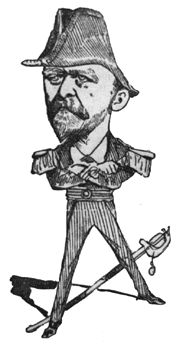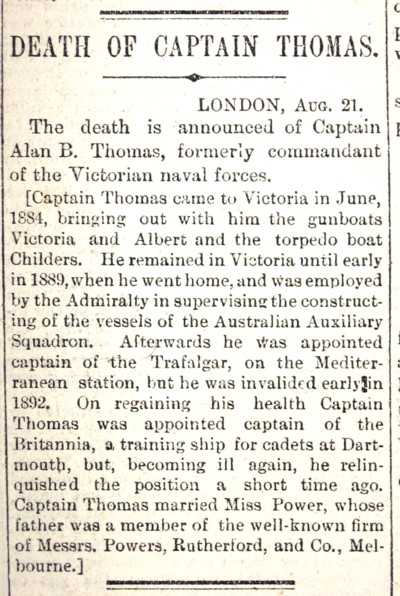|
Alan Broderick Thomas
Captain

Captain Alan B. Thomas RN, CB, formerly commanding the Victorian Naval Forces died at Steyning, Sussex, in August 1894. Captain Thomas was born in 1844, and entered the Royal Navy in 1856. He became a sub-lieutenant in 1864, and joined the Tribune on the Pacific Station where he earned his promotion to the rank of lieutenant and served another turn on that station in Charybdis. Commander Thomas was at the bombardment of Alexandria in July 1882, in the Alexandra, under Captain C. F. Hotham, wearing the flag of Vice-Admiral Sir Francis Seymour. Commander Thomas subsequently served ashore with the Naval Brigade during that campaign and the next year came to Victoria as Commandant of the Naval Forces. He relinquished this position in 1889, and returned to England to supervise the fitting out of colonial warships until he was appointed captain of the battleship Trafalgar and subsequently commanded the Britannia, a Dartmouth training ship, until his death.
excerpt from Deeds not Words by Wilson P. Evans, Hawthorn Press 1971
Captain Thomas, generally known as "Rorty" Thomas, had a habit of wearing trousers hitched remarkably high, and a middy's cap. Once, on stepping ashore at Townsville, he was so chaffed by a burly wharf laborer that he threw off his coat and , began to fight him. In the fray the wharfie lost his balance and fell into the river, whereupon the captain plunged in, pulled, him ashore, and presented him with half a guinea!
The Richmond River Herald & Northern Districts Advertiser, 17 July 1923
THE NAVAL COMMANDER FOR VICTORIA.
The Argus September 18, 1883
The following particulars of the "service " career of Captain Alan Broderick Thomas, the new naval commander for Victoria, have been obtained from an authentic source:- Captain Thomas was born on 24th February, 1844, and is, therefore, 39years of age. He joined the service on the 14th August 1856, and entered on board H.M. steam line-of-battle ship Caesar, 91 guns cruising in the channel and coast of Portugal. From the Caesar he was sent in H.M. sloop Vixen in February, 1857, to the sailing line-of-battle ship Monarch. 84 guns, on the Pacific station.
Returning to England, in July, 1858, he was again sent to the Caesar, then on the Mediterranean station, where he served till February, 1862. He was next appointed to H.M. steam frigate Tribune, 23 guns, and served in her on Pacific station till May, 1866. During her commission he became (July 1863) a sub lieutenant of H.M. screw corvette Charybdis, 17 guns, and served in her on The Australian station till November, 1868, when the ship was transfered to the Pacific station, where she remained until 1871, returning to England in August of that year. In October, 1872, he was appointed first lieutenant of H.M. screw frigate Immortalite, 28 guns. This vessel formed one of the then Detached Squadron, and visited the West Indies, Coast of Nova Scotia, Mediterranean, West Coast of Africa, South-east Coast of America, Falkland Isles, and Cape of Good Hope, then being ordered to Bombay to receive the Prince of Wales on the occasion of his visit to India. After this the Immortalite was sent to China and Japan, finally returning to England via Mauritius and the Cape in May, 1877. During this commission, he was three times given a commission as acting-commander, owing to changes in the fleet, but did not attain confirmed rank as commaner till 25th March 1878. On the same date he was appointed to H.M.S. Monarch, armour-plated turret ship, and served in her on the Mediterranean station for nearly three years, in the course of which he acted as beach-master during the occupation of Cyprus by the British troops; and, for the manner in which he carried out that arduous duty, he was highly commended by the Commaner-in Chief on the station, and by the Duke of Endinburgh, under whose immediate orders he served. He was afterwards still in the Monarch stationed in the Sea of Marmora during the Russo-Turkish war. From the Monarch he was transferred in January, 1881, to H.M.S. Alexandra, armour-plated ship 26 guns, flagship of Admiral Sir Beauchamp Seymour (now Lord Alcester), remaining in her until after the bombardment of Alexandria, when he was employed on shore with the Naval Brigade until the withdrawal of the fleet to Port Said, when he was shortly after superseded on promotion to the rank of captain, and returned to England September, 1882. He was most favourably mentioned in the despatches sent after the bombardment, and his commission as captain bears date July 11, 1882, the date of the bombardment. He is in possession of the Egyptian Medal and Khedive's Star. His active service at sea is as follows:-
Naval Cadet ...
Midshipman ... August 14, 1856, to September 18, 1885
Sub-Lieutenant ... This was all sea time with the exception of three month's leave and nine months when he was invalided home from the Caesar. Roughly speaking eight years' active sea time. September, 1865, to May 1866.
Lieutenant ... January, 1867, to August, 1871.
March, 1872, to June, 1872.
October, 1872, to May 1877.
Ten years one month active sea time.,
Commander ... March, 1878, to September, 1882.
Four years six months active sea time.
CAPTAIN THOMAS, R.N., commandant of the naval forces of Victoria, recently notified the Government that, on the expiration of the term for which he was engaged, he intended to return to England and rejoin the Royal Navy. The reason which caused CAPTAIN THOMAS to give up his present post was the refusal of the Admiralty to recognise service in the Colonial naval forces as counting towards seniority in the British navy. It is admitted that the Colonial forces are greatly in need of experienced officers, and that their efficiency is much improved by supervision from men like . CAPTAIN THOMAS, whose life has been spent in the regular service. But the Admiralty seemed to be deliberately putting obstacles in the way. It is only natural that naval officers should hesitate to accept engagements which diminish their none too plentiful chances of promotion. Promotion and seniority ought to be the reward of serving one's country, not here or there, but anywhere. Is not the country benefited as fully by service in Australia as in the Channel? Considering the importance of building up a trustworthy system of Colonial defence, it would be more reasonable to give officers increased seniority for taking part in the work than to refuse to recognise the years devoted to duties so efficiently and profitably performed.
THE intelligence is therefore peculiarly gratifying that the Admiralty has relented, and given its consent to the extension of CAPTAIN THOMAS'S appointment for three years, which will be allowed to count for seniority. There is a curious condition attached to the permission, that the Victorian Government is to "change the title of CAPTAIN THOMAS to that of CAPTAIN of the CERBERUS, and in command of the Victorian naval forces." No doubt there is a hidden virtue in the new style, which we do not attempt to probe ; the practical result is excellent.
Imperial Federation, 1887. Vol II January to December 1887

The Australasian, 14 April 1888  The Argus, 22 August 1894 The Argus, 22 August 1894 |

